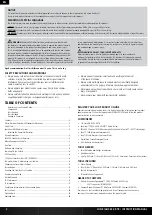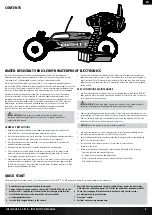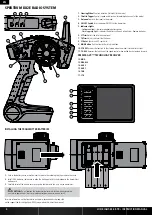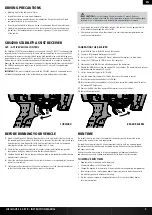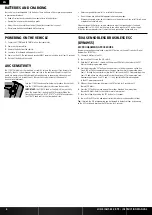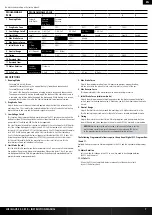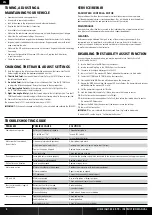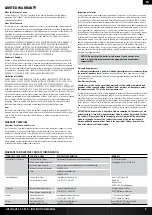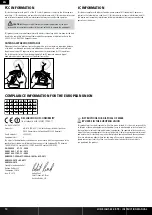
3
EN
LOSI 8IGHT-E 3.0 RTR • INSTRucTION maNuaL
contents
Your new Horizon Hobby vehicle has been designed and built with a combination of
waterproof and water-resistant components to allow you to operate the product in many
“wet conditions”, including puddles, creeks, wet grass, snow and even rain.
While the entire vehicle is highly water-resistant, it is not completely waterproof and your
vehicle should NOT be treated like a submarine. The various electronic components used in the
vehicle, such as the Electronic Speed Control (ESC), servo(s) and receiver are waterproof, how-
ever, most of the mechanical components are water-resistant and should not be submerged.
Metal parts, including the bearings, hinge pins, screws and nuts, as well as the contacts
in the electrical cables, will be susceptible to corrosion if additional maintenance is not
performed after running in wet conditions. To maximize the long-term performance of your
vehicle and to keep the warranty intact, the procedures described in the “Wet Conditions
Maintenance” section below must be performed regularly if you choose to run in wet
conditions. If you are not willing to perform the additional care and maintenance
required, then you should not operate the vehicle in those conditions.
CAUTION:
Failure to exercise caution while using this product and
complying with the following precautions could result in product malfunction
and/or void the warranty.
GENERAl PRECAUTIONS
• Read through the wet conditions maintenance procedures and make sure that you
have all the tools you will need to properly maintain your vehicle.
• Not all batteries can be used in wet conditions. Consult the battery manufacturer before
use. Caution should be taken when using Li-Po batteries in wet conditions.
• Most transmitters are not water-resistant. Consult your transmitter’s manual or the
manufacturer before operation.
• Never operate your transmitter or vehicle where lightning may be present.
• Do not operate your vehicle where it could come in contact with salt water (ocean
water or water on salt-covered roads), contaminated or polluted water. Salt water
is very conductive and highly corrosive, so use caution.
• Even minimal water contact can reduce the life of your motor if it has not been certified
as water-resistant or waterproof. If the motor becomes excessively wet, apply very light
throttle until the water is mostly removed from the motor. Running a wet motor at high
speeds may rapidly damage the motor.
• Driving in wet conditions can reduce the life of the motor. The additional resistance of
operating in water causes excess strain. Alter the gear ratio by using a smaller pinion or
larger spur gear. This will increase torque (and motor life) when running in mud, deeper
puddles, or any wet conditions that will increase the load on the motor for an extended
period of time.
WET CONDITIONS MAINTENANCE
• Drain any water that has collected in the tires by spinning them at high speed. With the
body removed, place the vehicle upside down and pull full throttle for a few short bursts
until the water has been removed.
CAUTION:
Always keep hands, fingers, tools and any loose or hanging objects
away from rotating parts when performing the above drying technique.
• Remove the battery pack(s) and dry the contacts. If you have an air compressor or a can
of compressed air, blow out any water that may be inside the recessed connector housing.
• Remove the tires/wheels from the vehicle and gently rinse the mud and dirt off with a
garden hose. Avoid rinsing the bearings and transmission.
NOTICE:
Never use a pressure washer to clean your vehicle.
• Use an air compressor or a can of compressed air to dry the vehicle and help remove
any water that may have gotten into small crevices or corners.
• Spray the bearings, drive train, fasteners and other metal parts with a water-displacing
light oil. Do not spray the motor.
• Let the vehicle air dry before you store it. Water (and oil) may continue
to drip for a few hours.
• Increase the frequency of disassembly, inspection and lubrication of the following:
- Front and rear axle hub assembly bearings.
- All transmission cases, gears and differentials.
- Motor—clean with an aerosol motor cleaner and re-oil the bushings
with lightweight motor oil.
Water-resIstant VehIcle WIth Waterproof electronIcs
QuIck start
Please read the entire manual to gain a full understanding of the 8IGHT-E™ 3.0 RTR buggy, fine-tuning the setup and performing maintenance.
1. Read the safety precautions found in this manual.
2. Charge the battery pack you have chosen (NOT INClUDED). Refer to the
Manufacturer’s Supplied instructions for battery charging information.
3. Install the AA batteries in the transmitter. Only use alkaline
or rechargeable batteries.
4. Install a fully charged battery in the vehicle.
5. Power ON the transmitter and then the vehicle. Always power the transmitter
ON before the vehicle and power it OFF after the vehicle has been powered OFF.
6. Check the steering and throttle control directions. Verify that the servos
are moving in the correct direction.
7. Drive your vehicle.
8. Perform any necessary maintenance.
3
LOSI 8IGHT-E 3.0 RTR • INSTRucTION maNuaL


